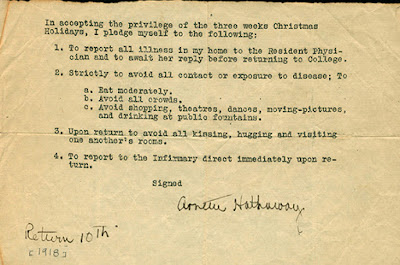In 1918, an influenza pandemic began to spread across the globe. In the U.S., about 28% of the population became infected, and 500,000 to 675,000 people died over the course the next two years. The campus of the State Normal and Industrial College (now UNCG) was, of course, not immune to this easily-transmitted disease. In October 1918, the disease found the College, and campus administrators had to made quick decisions on the best course of action to protect the students and limit the spread of the flu.
Instead of suspending operations as some schools did at the time, State Normal President Julius Foust made the decision to instead quarantine students to the campus. From October through December, students were unable to leave campus, and guests were not permitted to visit. One alumnae wrote:
“It was that fall when the Fourth Horseman on his livid steed was abroad in the land. Pestilence, in the form of deadly influenza epidemic, was sweeping the country. No city, village, or hamlet was spared. It reached the campus as I remember in October. Several hundred girls contracted it … A rigid quarantine was enforced. No one was allowed to leave the campus, no going to town, no weekends at home, only walks into the country were permitted.”
Several hundred students were infected — so many that the campus infirmary could not hold them all. Wooden Dormitory (also known as Guilford Hall) was converted into a makeshift hospital. But fortunately, none of the students contracted pneumonia, and no deaths resulted. As President Foust wrote in his unpublished history of the College, “This was remarkable in view of the fact that many more people died from flu in this country than were killed in the war [note: Foust is referring to World War I]. Both faculty and students had relatives and friends in the army and frequently a report would come that a loved one had been killed or died from influenza, but these sorrows were endured with Christian fortitude.”
By December, the influenza outbreak on campus had subsided enough that Foust decided that the students should be allowed to return home for the holiday break. But each student was required to sign an agreement pledging to report any illnesses in their home, avoid possible sources of the disease, and reporting to the infirmary for a health assessment immediately upon returning to the school.
When the holiday period end and student returned to State Normal, they faced a week of final exams. But, as soon as those were complete, they began to celebrate the end of the semester and of the full campus quarantine by planning a large gala event for the evening of February 3, 1919. As reported in the Greensboro Daily News:
“Memories of long, dreary weeks of quarantine were forgotten, and mirth reigned supreme through the spacious dining hall, when at 7:30 o’clock last evening students of the State Normal and Industrial College participated in one of the most elaborate entertainments in the history of the college.
The first event of the evening was, perhaps, the most impressive when 700 young ladies, dressed in quaint costumes, formed a long, gala procession and passed in review before the judging members of the faculty … After the procession had ended a unique program, arranged by Misses Clarence Winder and Lula Martin McIver, was given, including farce scenes of “what might have been” and “what actually happened” during the quarantine. A liberal sprinkling of humor was traced through the numerous sketches given, and the effect was indeed ludicrous.
During the latter hours of the evening a delightful dance was given in which the majority of the young ladies participated. Between dances several vaudeville sketches were presented, including aesthetic dancing, ballet scenes in which the students were dressed in colonial costumes, “buck and wing dancing,” and other forms of the Terpischorean art.”
By Erin Lawrimore

